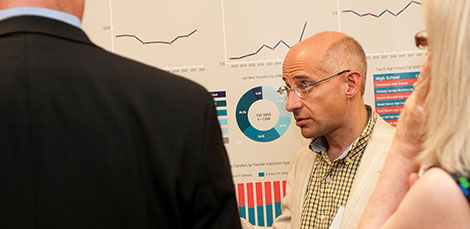In the shadow of a guard tower and an electrified fence at the Maryland Correctional Institute for Women in Jessup, a simple patch of wildflowers blooms.
But look more closely at the yellow partridge peas, red Indian blankets, and dozens of other species most of which are native to Maryland and you’ll see a carefully designed set of 25 distinct plots.
Two or three times a week, a few inmates come here to cultivate these plots -– and to take careful notes about the plants’ progress. “This has been a joy,” says L.J., an inmate in her late twenties. “My family has a camp up in Cecil County, and this is the closest thing I can experience to being up there.”
Prison gardens aren’t unusual. But the wildflower plots at Jessup aren’t like most prison gardens The inmates who tend them are being trained to harvest scientific data as part of an experiment being directed by Anna L. Johnson, a doctoral student in geography and environmental systems at UMBC, under the auspices of the Maryland Green Prisons Initiative.
The initiative is a collaboration between UMBC and the Maryland Department of Public Safety and Correctional Services, and its leaders have huge ambitions for the project. They would like to allow dozens of inmates to earn certifications in gardening and horticulture that might help them find jobs post-release. They envision fruit and nut orchards in greenhouses and fields at prison facilities throughout Maryland – and reduce by 90 percent the amount of solid waste generated at those same facilities.
The project leaders would also like to re-landscape hundreds of vacant lots in Baltimore City by planting native Maryland wildflowers. Anna Johnson’s garden plots at the women’s prison are a crucial step toward that last goal.
Johnson and her inmate partners have planted 16 plots here, with various combinations of native species. Each week, L.J. and other inmates gather data about each plot’s soil quality, species diversity, total biomass, and the number of bees and other pollinators they attract. They want to discover the optimal species mix recipe for seeding vacant lots in Baltimore. Once that recipe has been established, the inmates will transform a few dozen vacant lots in Baltimore’s Harlem Park neighborhood.
“All of our projects have to do with integrating primary research about sustainability and preserving biodiversity in an urban habitat, and at the same time providing education and training for pre-release inmates,” says Christopher Swan, an associate professor of geography and environmental systems at UMBC.
The initiative was born last fall, when Swan got a call from an old graduate-school friend on the west coast. His friend is part of the Sustainability in Prisons Project, a national network of scholars, activists, and correctional officers, and she had heard that Maryland prison officials were looking for academic collaborators for environmental projects.
“I was an inch away from saying, ‘You’ve got to be kidding – there’s no way I want to touch this,’” says Swan. He already had a huge amount on his plate, teaching courses at UMBC and serving as a co-principal investigator of the Baltimore Ecosystem Study, a multimillion-dollar analysis of human influences on soil, water, plants, and animal life in central Maryland. Bringing prisoners into the mix sounded like a massive logistical burden that did not promise much payoff.
Swan did agree to have a phone conversation with William Merritt, the Maryland prison system’s executive director for environmental compliance, safety, and emergency operations. Merritt turned out to be energetic, sharp, and unpretentious. By the end of the call, Swan somehow found himself agreeing to collaborate. He’d been persuaded that training prisoners might deepen the Baltimore Ecosystem Study’s ties with the community – and also that prisoners could regularly collect data about plants at their sites, allowing certain research projects to be conducted at much larger scales than would otherwise be possible.
“When you think of prisons, there’s usually a cloud of negativity, and obviously our state system has some severe problems,” Swan says. “But the people we’ve worked with in the agency – I just can’t emphasize enough how great they’ve been. When there’s a problem, everyone hops right up to help.”
For his part, Merritt is equally grateful to have found partners at UMBC. “Working with Chris has been a godsend in terms of finding likeminded people,” he says.
Swan has helped forge a connection, for example, between the prison system and the Baltimore Orchard Project, a nonprofit organization that helps plant trees at schools and churches. If all goes well, later this year inmates at the Maryland Metropolitan Transition Center, a prison in Baltimore City, will be trained to grow American chestnut and pecan seedlings in a greenhouse. Once the trees reach a certain size, they will be transplanted to a new orchard on the site of a decommissioned boot camp in Jessup, down the road from the women’s prison. And when they grow yet larger, many of those trees will be transplanted to the grounds of schools and churches in Baltimore.
“This kind of work fits in perfectly with our mission,” says Betty Johnson, the chief warden of the department’s pre-release program. “We’re constantly trying to provide services that allow our inmates to give back to the community. A lot of these guys will go back to the city after they’re released, and they’ll be able to point to these projects and know that they helped.”
The hope is that for at least a few inmates, the orchard projects will lead not only to a sense of personal accomplishment but also to skills that can be brought to the labor market. “Fruit and nut trees are very complicated,” Swan says. “Propagating the stock, doing the grafting – if you learn how to do that well, that should be a marketable skill post-release. We’re working on finding certifications that the inmates will be able to take to employers.”
Back at the women’s prison in Jessup, the inmates who work with Anna Johnson on the wildflower plots say they value the experience because it gives them a respite from the routines of incarceration.
“I come here once or twice a week,” says C.B., an inmate in her thirties. “It gives you time to meditate. It’s something totally out of the box.”
In addition to the wildflower plots, Johnson has also helped the inmates construct a vegetable garden on three raised beds at the center of the prison campus. “I wanted to give the women another way to get involved, because the experimental plots involve a lot of sitting and waiting,” Johnson says. “And the vegetable gardens really took off. They’ve got a lot of visibility, and they’ve become a center of activity.”
“I live for this,” says R.S., an inmate who volunteers in the vegetable garden twice a week after she finishes her night job in the prison’s mental-health clinic. “This is the closest thing to being at home.”
Thirteen inmates were chosen through an interview process last spring to work in the gardens. Johnson says she wanted to find at least a few inmates who already had gardening skills (one participant, for example, once worked as a volunteer docent at the U.S. National Arboretum in Washington). But she has also been happy to provide training to those without experience.
“It’s not really our study,” says S.D., an inmate in her thirties who is leading a trainee seeing-eye dog around the edge of the experimental plots. “But it’s good for us to get out here. I just gave Anna an update on my plots.”
“This is the only project I’ve experienced that’s been anything like this,” says Tanieka Scott-Black, the prison’s environmental compliance and safety officer, who is the primary on-site supervisor of the gardens. “In the past, we’ve just been working on site maintenance. But a lot of the officers here have really committed to this. When it came time to harvest from the vegetable gardens, people brought in equipment from home.”
Scott-Black and Johnson have an excellent rapport, but they’ve had to negotiate a few issues along the way. Metal stakes in the gardens? That would be a no. (They’re using small wooden stakes instead.) The prison also requires that no growth be taller than two feet – “I’d really be more comfortable with eighteen inches,” Scott-Black says – so that sight lines can be preserved. And because the experimental plots are in a relatively remote corner of the prison, only a few inmates have been approved to go there independently. (Those are the inmates who, like S.D., are also participating in training seeing-eye dogs. The dogs’ shed is near the wildflower plots, and a single guard can watch the inmates as they work on both projects.)
“Officers can be skeptical at first,” Swan says. “But what the Sustainable Prisons Project has learned nationally is that this kind of work is generally a win-win. Some good things get done, and the prison environment becomes safer. When they’re working on these projects, inmates aren’t doing other things that might cause problems. Something positive is going on.”
In addition to building trust with inmates and prison officials, Swan has also been working to build trust with neighborhood leaders in Baltimore. No work has been done yet outside the prison walls, but Swan and Merritt hope that next year will see prisoners participating in dozens of vacant-lot rehabilitation and tree-planting efforts in the city.
“We want to get buy-in from as many community groups as possible,” Swan says. “And that’s a lot of hard work. People are positive—I’ve actually never run into anything negative—but it’s been a lot of legwork.”
Merritt says that he and his colleagues will listen carefully to neighborhood groups’ opinions about what the vacant lots should look like. When people express anxiety about prisoners coming into their neighborhoods to do this work, he tells them: “These are pre-screened inmates who are close to release. They have to be infraction-free. They’ll have a guard with them at all times. We have a lot of experience bringing inmates onto road crews, and this really isn’t so different.”
But Merritt adds that this project could be a much deeper experience for the inmates than typical road work. They will, after all, be planting a mix of wildflowers based on the data now being painstakingly collected at the women’s prison. “When we go to national conferences of the Sustainability in Prisons project, that is what has impressed people the most — the idea that we’re training inmates to do technical data gathering,” Merritt says.
Swan now has more on his plate than ever. This spring, he oversaw the construction of a new greenhouse on the UMBC campus, where undergraduate researchers will do plant studies that parallel the ones being conducted at the women’s prison. This fall, he will help with building a greenhouse at the Maryland Metropolitan Transitional Center in Baltimore. (“But first I need to figure out a way to anchor a greenhouse on a concrete prison yard, so that it doesn’t blow away like a kite.”)
Meanwhile, Johnson has helped plant a second set of experimental wildflower plots at a prison on the Eastern Shore. Lynn Cazabon, an associate professor of photography at UMBC, is planning to do a series of portraits of inmates in the gardens. And Merritt is about to launch a composting program that he hopes will radically reduce the amount of solid waste that comes from Maryland prisons.
“I have never encountered this much enthusiasm for anything that I’ve done,” Swan says. “We’re getting to do a ton of real science, and with any luck we’ll help to inform sustainability policies for Baltimore City for a long time to come.”
– David Glenn
Tags: Fall 2013




